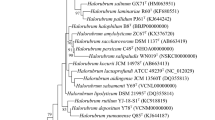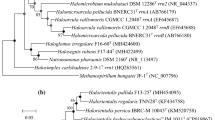Abstract
Lamprobacter, the genus of halophilic purple sulfur bacteria (PSB) with the single species Lpb. modestohalophilus was described in 1979. Rod-shaped Lamprobacter cells contained gas vesicles during the nonmotile growth phase; motile cells without gas vesicles were sometimes formed. Bacteria contained bacteriochlorophyll a and a carotenoid okenone. The names of this genus and species were included in the list of approved microbial names in 1988. Since the type strain Lpb. modestohalophilus RO1T has been lost, its 16S rRNA gene sequences have not been obtained. Based on analysis of the 16S rRNA genes, a new genus Halochromatium comprising the motile extremely halophilic Chromatium-like species was proposed in 1998. Members of this genus never contain gas vesicles. In spite of the phenotypic differences between the genera Lamprobacter and Halochromatium, phylogenetic boundaries between these taxa remained undetermined. Description of a marine bacteria formerly belonging to Lamprobacter according to its morphological and physiological properties as a new Halochromatium species, Hch. roseum, resulted in additional complication of the taxonomic situation. The present work provides evidence for the preservation of two phenotypically and phylogenetically different genera, Lamprobacter and Halochromatium, Lpb. modestohalophilus is proposed as the type species of the genus Lamprobacter. Characteristics of two Lpb. modestohalophilus strains were extensively investigated, and one of them (strain Sivash) was proposed as the neotype strain of the species. It was suggested to retain the genus Halochromatium as containing extremely halophilic species Hch. salexigens and Hch. glycolicum, while transfer of the weakly halophilic species Hch. roseum to the genus Lamprobacter is proposed, resulting in a new combination Lamprobacter roseus comb. nov.
Similar content being viewed by others
References
Gorlenko, V.M., Krasil’nikova, E.N., Kikina, O.G., and Tatarinova, N.Yu., The new motile purple sulfur bacteria Lamprobacter modestohalophilus nov. gen., nov. sp. with gas vacuoles, Izv. Akad. Nauk SSSR. Ser. Biol., 1979, vol. 5, pp. 755–767.
Krasil’nikova, E.N., Zhukov, V.G., and Kondrat’eva, E.N., Glycerin metabolism in purple sulfur bacteria, Microbiology, 1979, vol. 48, no. 4, pp. 463–467.
Malofeeva, I.V., Use of urea by purple bacteria, Microbiology, 1979, vol. 48, no. 3, pp. 315–321.
Gorlenko, V.M., Krasil’nikova, E.N., Kikina, O.G., and Tatarinova, N.Y., Validation of the publication of new names and new combinations previously effectively published outside the IJSB, Int. J. Syst. Bacteriol., 1988, vol. 38, pp. 220–222.
Gorlenko, V.M., Genus V. Lamprobacter Gorlenko, Krasil’nikova, Kikina and Tatarinova 1988, 220VP, in Bergey’s Manual of Systematic Bacteriology, 2nd ed., Staley, J.T., Bryant, M.P., Pfennig, N., and Holt, J.G., Eds., Baltimore: Williams and Wilkins, 1989, vol. 3, pp. 1647–1649.
Gorlenko, V.M., Genus V. Lamprobacter Gorlenko, Krasil’nikova, Kikina and Tatarinova 1988, 220VP, in Bergey’s Manual of Systematic Bacteriology, 2nd ed., Brenner, D.J., Krieg, N.R., Staley, J.T., and Garrity, G.M., New York: Sringer, 2005, vol. 2, pp. 16–18.
Sidorova, T., Makhneva, Z.K., Puchkova, N., Gorlenko, V., Moskalenko, A., Pigment-protein complexes from the purple sulfur photosynthetic bacterium Lamprobacter sp. that contains the carotenoid okenone, Doklady Biochem., 1998, vol. 361, no. 3, pp. 118–121.
Zadvornyi, O.A., Zorin, N.A., Gogotov, I.N., and Gorlenko, V.M., Properties of stable hydrogenase from the purple sulfur bacterium Lamprobacter modestohalophilus, Biochemistry (Moscow), 2004, vol. 69, no. 2, pp. 164–169.
Tourova, T.P., Kovaleva, O.L., Bumazhkin, B.K., Patutina, E.O., Kuznetsov, B.B., Bryantseva, I.A., Gorlenko, V.M., and Sorokin, D.Yu., Application of ribulose-1,5-bisphosphate carboxylase/oxygenase genes as molecular markers for assessment of the diversity of autotrophic microbial communities inhabiting the upper sediment horizons of the saline and soda lakes of the Kulunda Steppe, Microbiology (Moscow), 2011, vol. 80, no. 6, pp. 812–825.
Lunina, O.N., Bryantseva, I.A., Akimov, V.N., Rusanov, I.I., Rogozin, D.Yu., Barinova, E.S., Lysenko, A.M., and Pimenov, N.V., Seasonal changes in the structure of the anoxygenic photosynthetic bacterial community in Lake Shunet, Khakassia, Microbiology (Moscow), 2007, vol. 76, no. 3, pp. 368–379.
Pfennig, N. and Lippert, K.D., Über das Vitamin B12-Bedürfnis phototropher Schwefelbakterien, Arch. Mikrobiol., 1966, vol. 55, pp. 245–256.
Ryter, A. and Kellenberger, E., Etude au microscope electronique des plasmes contenant de l’acide deoxyribonucleique. 1. Les nucleoides des bacteries en croissance active, Z. Naturforsch., A: Phys. Sci., 1958, vol. 13b, pp. 597–605.
Reznikov, A.A., Mulikovskaya, E.P., and Sokolov, I.Yu., Metody analiza prirodnykh vod (Methods for Analysis of Natural Waters), Moscow: Nedra, 1970.
Dodgson, K.S., Determination of inorganic sulphate in studies on the enzymatic and nonenzymatic hydrolysis of carbohydrate and other sulphate esters, Biochem. J., 1961, vol. 78, pp. 312–329.
Marmur, J., A procedure for the isolation of deoxyribonucleic acid from microorganisms, J. Mol. Biol., 1961, vol. 3, pp. 208–218.
Owen, R.J., Hill, L.R., and Lapage, S.P., Determination of DNA base composition from melting profiles in dilute buffers, Biopolymers, 1969, vol. 7, pp. 503–516.
De Lay, J., Cattoir, H., and Reynaerts, A., The quantitative measurement of DNA?DNA hybridization from renaturation rates, Eur. J. Biochem., 1970, vol. 12, pp. 133–142.
Bulygina, E.S., Kuznetsov, B.B., Marusina, A.I., Turova, T.P., Kravchenko, I.K., Bykova, S.A., Kolganova, T.V., and Gal’chenko, V.F., A study of nucleotide sequences of nifH genes of some methanotrophic bacteria, Microbiology (Moscow), 2002, vol. 71, no. 4, pp. 425–432.
Lane, D.J., 16S/23S rRNA sequencing, in Nucleic Acid Techniques in Bacterial Systematics, Stackebrandt, E. and Goodfellow, M., Eds., Chichester, UK: Wiley, 1991, pp. 115–177.
Caumette, P., Baulaique, R., and Matheron, R., Characterization of Chromatium salexigens sp. nov., a halopilic Chromatiaceae isolated from Mediterranean Salinas, Syst. Appl. Microbiol., 1988, vol. 10, pp. 288–292.
Caumette, P. Imhoff, J.F., Süling, J., and Matheron, R., Chromatium glycolicum sp. nov., a moderately halophilic purple sulfur bacterium that uses glycolate as substrate, Arch. Microbiol., 1997, vol. 167, pp. 11–18.
Imhoff, J.F., Süling, J., and Petri, R., Phylogenetic relationship among the Chromatiaceae, their taxonomic reclassification and description of the new genera Allochromatium, Halochromatium, Isochromatium, Marichromatium, Thiococcus, Thiohalocapsa and Thermochromatium, Int. J. Syst. Bacteriol., 1998, vol. 48, pp. 1129–1143.
Imhoff, J.F., True marine and halophilic anoxygenic phototrophic bacteria, Arch. Microbiol., 2001, vol. 176, pp. 243–254.
Kumar, P.A., Srinivas, T.N.R., Sasikala, Ch., and Ramana, Ch.V., Halochromatium roseum sp. nov., a non-motile phototrophic gammaproteobacterium with gas vesicles, and emended description of the genus Halochromatium, Int. J. Syst. Evol. Microbiol., 2007, vol. 57, pp. 2110–2113.
Tindall, B.J., Misunderstanding the bacteriological code, Int. J. Syst. Bacteriol., 1999, vol. 49, pp. 1313–1316.
International Code of Nomenclature of Bacteria (1990 Revision). Bacteriological Code, Lapage, S.P., Sneath, P.H.A., Lessel, E.F., Skerman, V.B.D., Seeliger, H.P.R., and Clark, W.A., Eds., Washington: Amer. Soc. Microbiol., 1992.
Imhoff, J.F. and Caumette, P., Genus III. Halochromatium Imhoff, Süling, Petri 1998, in Bergey’s Manual of Systematic Bacteriology. 2nd ed., Brenner, D.J., Krieg, N.R., Staley, J.T., and Garrity, G.M., Eds., New York: Springer, 2005, vol. 2, pp. 14–15.
Author information
Authors and Affiliations
Corresponding author
Rights and permissions
About this article
Cite this article
Gorlenko, V.M., Bryantseva, I.A., Lunina, O.N. et al. Phylogenetic position of the purple sulfur bacterium Lamprobacter modestohalophilus determined based on the data on new strains of the species. Microbiology 83, 829–837 (2014). https://doi.org/10.1134/S0026261714060071
Received:
Published:
Issue Date:
DOI: https://doi.org/10.1134/S0026261714060071




